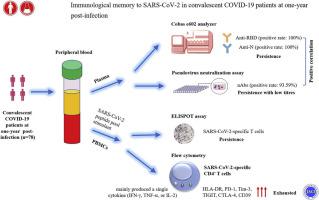Journal of Allergy and Clinical Immunology ( IF 11.4 ) Pub Date : 2021-09-15 , DOI: 10.1016/j.jaci.2021.09.008 Hongyan Hou 1 , Yandi Zhang 2 , Guoxing Tang 1 , Ying Luo 1 , Wei Liu 1 , Chang Cheng 3 , Yuhuan Jiang 4 , Zhigang Xiong 1 , Shiji Wu 1 , Ziyong Sun 1 , Shabei Xu 3 , Xionglin Fan 2 , Feng Wang 1

|
Background
Understanding the complexities of immune memory to severe acute respiratory syndrome coronavirus 2 (SARS-CoV-2) is key to gain insights into the durability of protective immunity against reinfection.
Objective
We sought to evaluate the immune memory to SARS-CoV-2 in convalescent patients with longer follow-up time.
Methods
SARS-CoV-2–specific humoral and cellular responses were assessed in convalescent patients with coronavirus disease 2019 (COVID-19) at 1 year postinfection.
Results
A total of 78 convalescent patients with COVID-19 (26 moderate, 43 severe, and 9 critical) were recruited after 1 year of recovery. The positive rates of both anti–receptor-binding domain and antinucleocapsid antibodies were 100%, whereas we did not observe a statistical difference in antibody levels among different severity groups. Accordingly, the prevalence of neutralizing antibodies (nAbs) reached 93.59% in convalescent patients. Although nAb titers displayed an increasing trend in convalescent patients with increased severity, the difference failed to achieve statistical significance. Notably, there was a significant correlation between nAb titers and anti–receptor-binding domain levels. Interestingly, SARS-CoV-2–specific T cells could be robustly maintained in convalescent patients, and their number was positively correlated with both nAb titers and anti–receptor-binding domain levels. Amplified SARS-CoV-2–specific CD4+ T cells mainly produced a single cytokine, accompanying with increased expression of exhaustion markers including PD-1, Tim-3, TIGIT, CTLA-4, and CD39, while the proportion of multifunctional cells was low.
Conclusions
Robust SARS-CoV-2–specific humoral and cellular responses are maintained in convalescent patients with COVID-19 at 1 year postinfection. However, the dysfunction of SARS-CoV-2–specific CD4+ T cells supports the notion that vaccination is needed in convalescent patients for preventing reinfection.
中文翻译:

感染后 1 年恢复期 COVID-19 患者对 SARS-CoV-2 的免疫记忆
背景
了解严重急性呼吸系统综合症冠状病毒 2 (SARS-CoV-2) 免疫记忆的复杂性是深入了解保护性免疫抵抗再感染的持久性的关键。
客观的
我们试图评估随访时间较长的恢复期患者对 SARS-CoV-2 的免疫记忆。
方法
在感染后 1 年的 2019 年冠状病毒病 (COVID-19) 恢复期患者中评估了 SARS-CoV-2 特异性体液和细胞反应。
结果
康复 1 年后,共招募了 78 名康复期 COVID-19 患者(26 名中度、43 名重度和 9 名危重)。抗受体结合域和抗核衣壳抗体的阳性率为 100%,而我们没有观察到不同严重程度组之间抗体水平的统计学差异。因此,恢复期患者中和抗体(nAbs)的患病率达到了 93.59%。尽管 nAb 滴度在严重程度增加的恢复期患者中显示出增加的趋势,但差异未能达到统计学意义。值得注意的是,nAb 滴度与抗受体结合域水平之间存在显着相关性。有趣的是,SARS-CoV-2 特异性 T 细胞可以在康复期患者中保持稳定,它们的数量与 nAb 滴度和抗受体结合域水平呈正相关。扩增的 SARS-CoV-2 特异性 CD4+ T细胞主要产生单一细胞因子,伴随着PD-1、Tim-3、TIGIT、CTLA-4、CD39等耗竭标志物的表达增加,而多功能细胞的比例较低。
结论
COVID-19 康复期患者在感染后 1 年保持稳健的 SARS-CoV-2 特异性体液和细胞反应。然而,SARS-CoV-2 特异性 CD4 + T 细胞的功能障碍支持了康复期患者需要接种疫苗以防止再次感染的观点。











































 京公网安备 11010802027423号
京公网安备 11010802027423号